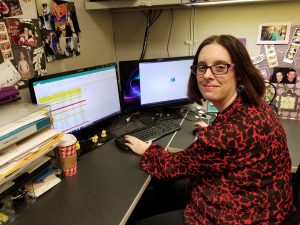Earlier this week, I stopped by the basement of the East Campus of Grays Harbor Community Hospital (GHCH) and met with specialists from the Information Technology (IT) department. Like their offices, the work of the IT folks tends to fly under the radar.

“When the technology is running smoothly, we are invisible,” says Brad Wallace, Director of IT. “But if you were to take IT out of healthcare, there would be minimal healthcare. We give the providers tools that make them better at what they do.”
Wallace leads a team of 10 professionals responsible for the technology and applications that handle the mounds of data flowing through the organization. This technology is critical to the hospital’s operations, from the electronic medical record, to network security, billing and the recently unveiled centralized scheduling.
Supporting Patient Care
Envision a post-operative patient recuperating at home. Late at night, he begins to experience troubling symptoms. A phone call to the office links the patient to the provider on call. Within seconds, the provider can access the patient’s complete medical record, assessing the situation and initiating care remotely.
The virtual desktop technology that makes this possible allows the provider secure access via tablet or smartphone to all of the necessary data and applications from any location. Providers can deliver care more quickly and efficiently. And the IT department works to continually improve that process.
“A year ago, it would take providers 30 to 40 seconds to log on to the virtual desktop,” says Stephen LaBounty, Senior Systems Engineer. “We were able to bring the login time down to about five seconds.”
That 25-35 seconds saved makes a big difference to the hurting patient on the other end of the line. Additionally, while on the phone, the provider may determine that the patient needs a new prescription to ease symptoms. GHCH providers now have the ability to electronically prescribe medications, including narcotics.
“E-prescribing is far more accurate and secure than simply handing the patient a piece of paper,” explains Jared Braaten, Clinical Informatics Nurse.

E-prescriptions reduce the chance that prescriptions will get lost or fall into the wrong hands. They are also trackable, making it much easier to build a detailed medication list for a patient, even if that patient shows up in the emergency department unresponsive.
“With a complete and up-to-date medication list, physicians can more accurately prescribe for their patients and provide more effective care,” says Braaten.
Helping Providers Do What They Do Best
The IT department works hard to extend the reach of the providers and make their work easier. To that end, Wallace meets regularly with GHCH providers to field their concerns and identify solutions.
Not long ago, the providers described a significant frustration with the documentation process. The system was cumbersome, and providers had to search through many thousands of diagnosis codes in order to complete patient charts.
Upon researching the options available, Wallace and his team discovered a software add-on that increased the ease of use and the accuracy of the coding process. “I’m getting feedback from the orthopedics providers that this product is saving them an hour a day,” reports Wallace. “The impact is significant.”
Providers are happier and more efficient. Charts, and therefore billing, are more accurate. And with that extra hour in the day, physicians can provide additional patient care.
Protecting Sensitive Data
Security is also essential in the healthcare arena. Protecting sensitive patient data has always been critical, and the past two years have seen a sharp increase in cyber-attacks worldwide. “From our standpoint, the number one area that we need to protect is patient data,” says Wallace. “A breach could bring us to our knees. It could stop all patient care.”

Photo courtesy : Grays Harbor Community Hospital
To protect against just such a scenario, the IT department found a new product that uses artificial intelligence to build a living profile for each device on the network. Just like your credit card company, the system immediately sends an alert when it senses unusual activity.
“At one point, someone was trying to launch a brute force entry attack on the system,” says LaBounty. “They tried to get a password of one of the main IDs on the network, and we were able to catch it right away. The program is invaluable to us.”
Much More than Computer Fixes
While they may work out of a basement, the IT staff not only fix computers; they do far more. Their work encompasses all of the data that makes the hospital hum, which helps providers deliver high quality care in the most efficient way possible.
Whether you are calling the contact center to make an appointment, reviewing an MRI scan with your primary care provider or being notified of possible drug interactions with a new prescription, all of that is made possible through the hard work of the information technology team at Grays Harbor Community Hospital.
Sponsored












































